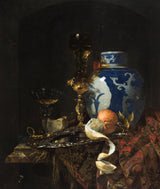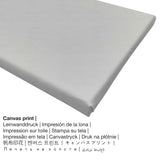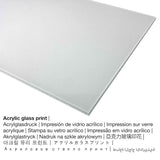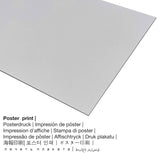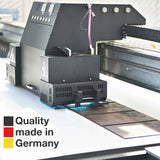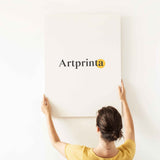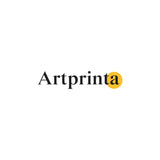Willem Kalf, 1669 - Ndụ ka nwere nnukwu ite nke China - mbipụta nka mara mma
Ụtụ gụnyere. Mbupu gbakọrọ na ndenye ọpụpụ.
Ngwaahịa nka nke onwe gị
Ọkachamara nke narị afọ nke 17 Still Life with a Chinese Porcelain Jar mere site Willem Kalf. The beyond 350 years old original measures the size 30-3/4 x 26 in. Mmanụ na kwaaji was used by the painter as the technique for the painting. This work of art belongs to the Indianapolis Museum of Art's collection located in Indianapolis, Indiana, United States of America. The classic art public domain artpiece is supplied with courtesy of Analọ ihe nkiri nka nke Indianapolis.Ebe E Si Nweta nke ihe osise:. Nhazi nke mmepụta dijitalụ bụ Eserese na nwere akụkụ ruru nke 1: 1.2, nke pụtara na ogologo bụ 20% mkpụmkpụ karịa obosara. The painter Willem Kalf was a European artist from the Netherlands, whose style can primarily be attributed to Baroque. The Dutch painter was born in 1619 na Rotterdam, South Holland, Netherlands wee nwụọ mgbe ọ dị afọ 74 na 1693.
Nye iwu ihe ị họọrọ
In the product dropdown lists you can pick the size and materialaccording to your preferences. You can select your preferred size and material between the following options:
- Aluminom ihe eji eme ihe: This is a metal print manufactured on aluminium dibond material with an impressive depth effect. For our Direct Aluminium Dibond print, we print the selected artpiece onto the surface of the aluminum. The colors are bright and luminous in the highest definition, the details of the print appear crisp and clear, and the print has a a matte appearance you can literally feel. This print on aluminium is one of the most demanded entry-level products and is an extremely sophisticated way to showcase fine art prints, because it puts 100% of the viewer’s attention on the artwork.
- Mbipụta iko acrylic (nke nwere ezigbo mkpuchi iko): A glossy acrylic glass print, often referred to as a print on plexiglass, changes an original into home décor and makes a distinct alternative to dibond and canvas fine art replicas. The major benefit of a plexiglass fine art print is that contrasts and also small color details become identifiable with the help of the subtle gradation in the picture.
- Mbipụta akwụkwọ mmado (akwa akwa akwa): Our poster print is a UV printed flat canvas with a fine surface finish. Please keep in mind, that depending on the absolute size of the poster print we add a white margin of around 2 - 6cm around the print motif, which facilitates the framing with your custom frame.
- Kwaaji: A canvas print is a printed cotton canvas mounted on a wood frame. A printed canvas of your favorite work of art will let you turn your individual fine art print into a large size artpiece as you know from art galleries. Canvas prints are relatively low in weight, meaning that it is easy and straightforward to hang up your Canvas print without additional wall-mounts. Canvas prints are suitable for any type of wall in your home.
Nkwupụta iwu: We try what we can in order to describe our products as exact as possible and to display them visually on the respective product detail pages. At the same time, the colors of the printed materials, as well as the print result can differ to a certain extent from the image on the screen. Depending on the settings of your screen and the condition of the surface, color pigments may not be printed 100% realistically. In view of the fact that our art prints are printed and processed manually, there might as well be minor differences in the size and exact position of the motif.
Nkọwapụta edemede
| Bipụta ngwaahịa: | ọrụ mgbidi |
| Usoro mmeghari: | dijitalụ mmeputakwa |
| Usoro mmepụta: | Mbipụta UV ozugbo |
| Mmalite ngwaahịa: | German mere |
| Stockdị ngwaahịa: | mmepụta ihe na-achọ |
| Eji ngwaahịa a chọrọ: | mkpokọta nka (mmeputakwa), mgbidi gallery |
| Ndozi onyonyo: | nhazi ihe osise |
| Oke akụkụ onyonyo: | 1:1.2- (ogologo: obosara) |
| Nsonaazụ: | ogologo bụ 20% mkpụmkpụ karịa obosara |
| Materials: | akwụkwọ mmado (akwụkwọ kwaaji), mbipụta ọla (aluminium dibond), mbipụta iko acrylic (nke nwere ezigbo mkpuchi iko), mbipụta akwụkwọ. |
| Kanvas n'elu etiti ihe ndọtị (mbipụta akwa akwa): | 50x60cm - 20x24", 100x120cm - 39x47", 150x180cm - 59x71" |
| Mbipụta iko acrylic (nwere ezigbo mkpuchi iko) dị iche iche: | 50x60cm - 20x24", 100x120cm - 39x47", 150x180cm - 59x71" |
| Ụdị akwụkwọ mmado (akwụkwọ kwaaji) dị iche iche: | 50x60cm - 20x24", 100x120cm - 39x47" |
| Mpempe akwụkwọ Dibony (ihe alumnium) nha dị iche iche: | 50x60cm - 20x24", 100x120cm - 39x47" |
| Igwe onyonyo: | enweghị etiti |
Data nka ahaziri
| Akụkụ nka: | "Still Life with a Chinese Porcelain Jar" |
| Nhazi nka: | sere |
| Otu sara mbara: | nka ochie |
| oge: | 17th narị afọ |
| Afọ nka: | 1669 |
| Ogologo afọ nka nka: | karịa afọ 350 |
| Usoro nka izizi: | mmanụ na kwaaji |
| Nha nke ihe osise izizi: | 30-3/4 x 26 nke anụ ọhịa |
| Ụlọ ihe ngosi nka: | Analọ ihe nkiri nka nke Indianapolis |
| Ebe ebe ngosi nka: | Indianapolis, Indiana, Njikota Obodo Amerika |
| Weebụsaịtị ihe ngosi nka: | Analọ ihe nkiri nka nke Indianapolis |
| Licensedị ikike: | ngalaba ọha |
| Site n'aka: | Analọ ihe nkiri nka nke Indianapolis |
Tebụl metadata omenkà
| Aha onye nka: | Willem Kalf |
| Aliases: | W.m Kalf, W. Kalff, Kalfe Willem, Kaalf Willem, קאלף וילם, Wilhelm Kalf, Kelf, Kalf Guillaume, Guillaume Kalff, Cal ou Kalf, Guillam Kalf, Kalf Willem, Calf, william kalff, W. Kalf, Kalft, kalf wilhelm, Willhelmus Kalf, G. Kalf, Wilh. Calf., V. G. Kalf, Calphe, Kalb, Kaalf, Kalff, G. Calf, Wilhelmus Kalf, William Kalf, Calff, Guillaume Kalf, Kalf., Wilh. Calf, Vilen G. Kalf, Guill. Kalf, Kalf, Half, W. von Calff, Willhelm Kalf, Kalff Willem, W. Calf, V.G. Kalf, Calfe, Guillaume Kalfft, Kalse, Willem Kalff, Calf Willem, Kalfe, Wilhelm Kalff, Golff, Willem Kalf |
| okike nke onye nka: | nwoke |
| Obodo onye nka: | Dutch |
| Ọrụ: | onye na-ese ihe |
| Obodo onye nka: | mba netherland |
| Otu nka: | nna ukwu ochie |
| Ụdị nka: | Baroque |
| Nwụrụ na afọ nke: | 74 afọ |
| Afọ ọmụmụ: | 1619 |
| Ebe omuma: | Rotterdam, South Holland, Netherlands |
| Nwuru: | 1693 |
| Obodo ọnwụ: | Amsterdam, North Holland, Netherlands |
© Copyright - Artprinta.com (Artprinta)
Original information about the artwork by Indianapolis Museum of Art website (© - Ụlọ ihe ngosi nka nke Indianapolis - Analọ ihe nkiri nka nke Indianapolis)
Galley label: When Willem Kalf painted this ostentatious still life, Amsterdam was the trading center of Europe. Turkish carpets, Venetian glass, Chinese porcelains and tropical fruits were just a few of the exotic commodities brought by Dutch traders to the bustling markets of the capital. The precious goods assembled here celebrate both the artist's skill and the wealth and enterprise of Holland's golden age.
Indianapolis Museum of Art Onyinye nke Oriakụ James W. Fesler na ebe nchekwa Daniel W. na Elizabeth C. Marmon

